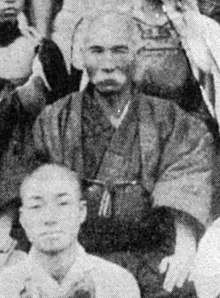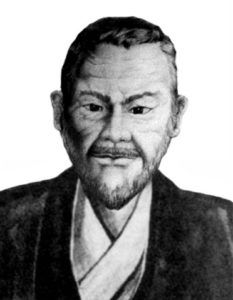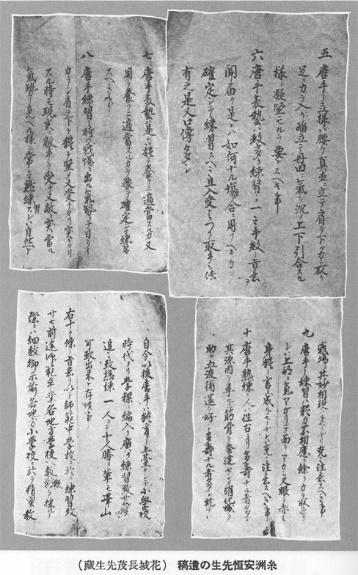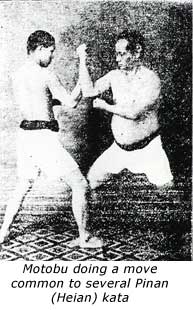 ANKO ITOSU
ANKO ITOSU
Master Anko Itosu (called Yasutsune Itosu in Japanese) was born in 1831 city of Shuri in Okinawa and died in 1915. A low-rank Ryūkyūan Pechin, Itosu was small in stature, shy, and introverted as a child. He was raised in a strict home of the keimochi (a family of position), and was educated in the Chinese classics and calligraphy. Itosu began his tode (karate) study under Nagahama Chikudun Pechin, where others speak of a Chinese of the name Channan. Around the age of 30, he became the disciple of Master Sokon Matsumura. He was also training along side another disciple by the name of Anko Azato who was the best student of Master Matsumura. Part of Itosu’s training was makiwara practice. He once tied a leather sandal to a stone wall in an effort to build a better makiwara. After several strikes, the stone fell from the wall. After relocating the sandal several times, Itosu had destroyed the wall.
Itosu served as a secretary to the last king of the Ryūkyū Kingdom until Japan abolished the Okinawa-based native monarchy in 1879. Itosu was a well-educated man and worked as King Sho Tai’s personal secretary, whom he served for thirty years. For Itosu and the rest of the inhabitants of the island, everything changed in 1879 as the Japanese ended the Royal dynasty of Okinawa, sending the king into exile. Most of the karate masters had worked for the King so as a result of his fall from grace many, including Itosu, suddenly found themselves living in abject poverty even though they were of the higher social class.
 Anko Itosu’s Influence on Karate
Anko Itosu’s Influence on Karate
While it can be difficult to know where true karate history ends and myths and legends begin, both these stories illustrate why Anko Itosu’s teachings are so important to karate history. It was him that popularised and possibly brought in the concept of finishing an opponent off with one blow, which is often delivered when the opponents begins their opening attack. Previously karateka, much like kung Fu practitioners, would attempt to overwhelm their opponents with less powerful rapid-fire techniques, use grappling moves or lighter strikes to vulnerable areas such as pressure points, the eyes or the groin. For this reason, the master’s karate is said to be the first that closely resembles what is practiced in Shotokan karate today, leading many to see Itosu as the Grandfather of Modern Day Karate.
In 1901, he was instrumental in getting karate introduced into Okinawa’s schools. In 1905, Itosu was a part-time teacher of To-te at Okinawa’s First Junior Prefectural High School. Itosu can be said to be the first person to practice what would closely resemble the type of Shotokan karate that is practiced today, and was responsible for taking the martial art from being a secretive, behind closed doors art, to being spread to the general public in Okinawa. It was here that he developed the systematic method of teaching karate techniques that are still in practice today. He created and introduced the Pinan forms (Heian in Japanese) as learning steps for students, because he felt the older forms (kata in Japanese) were too difficult for schoolchildren to learn. The five Pinan forms were (allegedly) created by drawing from two older forms: Kusanku and Chiang nan. Itosu is also credited with taking the large Naihanchi form (tekki in Japan) and breaking it into the three well-known modern forms Naihanchi Shodan, Naihanchi Nidan, and Naihanchi Sandan. There is some controversy as to where Itosu learned the Naihanchi kata. Some give credit to Matsumura for teaching this kata to Itosu. However, others say differently, and here is where we first start to see reference to Channan, as the name of a person. It is said that a Chinese sailor who was shipwrecked on Okinawa hid in a cave at Tomari. It was from this man that Itosu supposedly learned the Naihanchi kata, among other things.
Itosu’s unique contributions to the art of Karate-do include not only his 1908 letter to the Japanese Ministry of Education and Ministry of War, expounding on the 10 precepts of Toudi training, but also the creation of several kata. These include not only the Pinan series, but also Naihanchi Nidan and Sandan, and possibly Kusanku Sho and Passai Sho. Another kata that has often been attributed to Itosu is the Shiho Kusanku Kata, but more recent evidence points to the actual originator of this paradigm to have been Mabuni Kenwa himself.
Anko Itosu and the Thief
Gichin Funakoshi referred to his teacher’s incredible ability to withstand blows, his vice-like grip and his amazing physical strength. Itosu was a well built, strong man who conditioned his body to be able to give and take the hardest of blows. He insisted his students regularly use the makiwara board, a pad that is repeatedly struck in order to make the hands tougher and used to high impact hits.
One story that illustrates this power tells of a thief who tried to break into the master’s house. When Itosu heard his wooden gate rattle, he went to investigate only to realise that on the other side was the thief trying to gain access. Itosu, so the legend goes, punched straight through the thick wooden gate, grasping the would-be thief by the arm and creating a gaping hole in the gate.
In 1908, Itosu wrote the influential “Ten Precepts (Tode Jukun) of Karate,” to draw the attention of the Ministry of Education and the Ministry of War in Japan, reaching beyond Okinawa to Japan. Itosu’s style of karate, Shorin-ryu, came to be known as Itosu-ryu in recognition of his skill, mastery, and role as teacher to many.
A translation of that letter reads:
Ten Precepts of Karate
Karate did not develop from Buddhism or Confucianism. In the past the Shorin-ryu school and the Shorei-ryu school were brought to Okinawa from China. Both of these schools have strong points, which i will now mention before there are too many changes:
-

Karate is not merely practiced for your own benefit; it can be used to protect one’s family or master. It is not intended to be used against a single assailant but instead as a way of avoiding a fight should one be confronted by a villain or ruffian. - The purpose of karate is to make the muscles and bones hard as rock and to use the hands and legs as spears. If children were to begin training in Tang Te while in elementary school, then they will be well suited for military service. Remember the words attributed to the Duke of Wellington after he defeated Napoleon: “The Battle of Waterloo was won on the playing fields of Eton.”
- Karate cannot be quickly learned. Like a slow moving bull, it eventually travels a thousand miles. If one trains diligently every day, then in three or four years one will come to understand karate. Those who train in this fashion will discover karate.
- In karate, training of the hands and feet are important, so one must be thoroughly trained on the makiwara. In order to do this, drop your shoulders, open your lungs, take hold of your strength, grip the floor with your feet, and sink your energy into your lower abdomen. Practice using each arm one to two hundred times each day.
- When one practices the stances of Tang Te, be sure to keep your back straight, lower your shoulders, put strength in your legs, stand firmly, and drop your energy into your lower abdomen.
- Practice each of the techniques of karate repeatedly, the use of which is passed by word of mouth. Learn the explanations well, and decide when and in what manner to apply them when needed. Enter, counter, release is the rule of releasing hand (torite).
- You must decide if karate is for your health or to aid your duty.
- When you train, do so as if on the battlefield. Your eyes should glare, shoulders drop, and body harden. You should always train with intensity and spirit, and in this way you will naturally be ready.
- One must not overtrain; this will cause you to lose the energy in your lower abdomen and will be harmful to your body. Your face and eyes will turn red. Train wisely.
- In the past, masters of karate have enjoyed long lives. Karate aids in developing the bones and muscles. It helps the digestion as well as the circulation. If karate should be introduced beginning in the elementary schools, then we will produce many men each capable of defeating ten assailants. I further believe this can be done by having all students at the Okinawa Teachers’ College practice karate. In this way, after graduation, they can teach at the elementary schools at which they have been taught. I believe this will be a great benefit to our nation and our military. It is my hope you will seriously consider my suggestion.
Anko Itosu, October 1908
This letter was influential in the spread of karate.
While Itosu did not invent karate himself, he modified the kata (forms) he learned from his master, Matsumura, and taught many karate masters. Itosu’s students included Choyu Motobu (1857–1927), Choki Motobu (1870–1944), Kentsu Yabu (1866–1937), Chomo Hanashiro (1869–1945), Gichin Funakoshi (1868–1957), Moden Yabiku (1880–1941), Kanken Toyama (1888–1966), Shinpan Shiroma (Gusukuma) (1890–1954), Anbun Tokuda (1886–1945), Kenwa Mabuni (1887–1952), and Chōshin Chibana (1885–1969).
Early Written References to Channan and Pinan
References to Channan can be found as far back as 1934. In the karate research journal entitled Karate no Kenkyu, published by Nakasone Genwa, Motobu Choki is quoted referring to the Channan and the Pinan kata:

“(Sic.) I was interested in the martial arts since I was a child, and studied under many teachers. I studied with Itosu Sensei for 7-8 years. At first, he lived in Urasoe, then moved to Nakashima Oshima in Naha, then on to Shikina, and finally to the villa of Baron Ie. He spent his final years living near the middle school.
I visited him one day at his home near the school, where we sat talking about the martial arts and current affairs. While I was there, 2-3 students also dropped by and sat talking with us. Itosu Sensei turned to the students and said ‘show us a kata.’ The kata that they performed was very similar to the Channan kata that I knew, but there were some differences also. Upon asking the student what the kata was, he replied ‘It is Pinan no Kata.’ The students left shortly after that, upon which I turned to Itosu Sensei and said ‘I learned a kata called Channan, but the kata that those students just performed now was different. What is going on?’ Itosu Sensei replied ‘Yes, the kata is slightly different, but the kata that you just saw is the kata that I have decided upon. The students all told me that the name Pinan is better, so i went along with the opinions of the young people.’ These kata, which were developed by Itosu Sensei, underwent change even during his own lifetime.”
Shiraguma no Kata
According to Tsukuo Iwai, one of Japan’s most noted Budo researchers and teacher of Choki Motobu’s karate in Gunma Prefecture, Motoburyu Karatejutsu, which is being preserved by Choki’s son, Chosei Motobu, in Osaka, contains what is known as Shiraguma no Kata, which he maintains used to be called Channan. He also states that this kata is “somewhat similar to the Pinan, yet different.”
The Other Side of the Coin
The flip side to this theory states that Itosu did not create the Pinan kata, but actually remodeled older Chinese-based hsing/quan/kata called Channan. This theory states that Itosu learned a series of Chinese Quan-fa hsing from a shipwrecked Chinese at Tomari, and reworked them into five smaller components, re-naming them Pinan because the Chinese pronunciation “Chiang-Nan” was too difficult.
It has been argued that the source for these Channan kata was a Chinese from an area called Annan, or a man named Annan. On the other hand, others say that the man’s name was Channan. Still others go into even more detail, stating that Itosu learned these hsing/kata from a man named Channan, and named them after their source, later adding elements of the Kusanku Dai kata to create the Pinan.
There is also interesting oral testimony passed down in the Tomari-di tradition that is propagated in the Okinawa Gojuryu Tomaridi Karatedo Association of Iken Tokashiki that states that Itosu learned the Channan/Pinan kata from a Chinese at Tomari in one day. The proponents of Tomari-di said that there was no need to learn “over-night kata” and that this is the reason that the Tomari traditions did not include instruction in the Pinan kata.
In conslusion, the evidence at hand seems to point not to a “long lost kata” but rather to the constant and inevitable evolution of a martial art.

